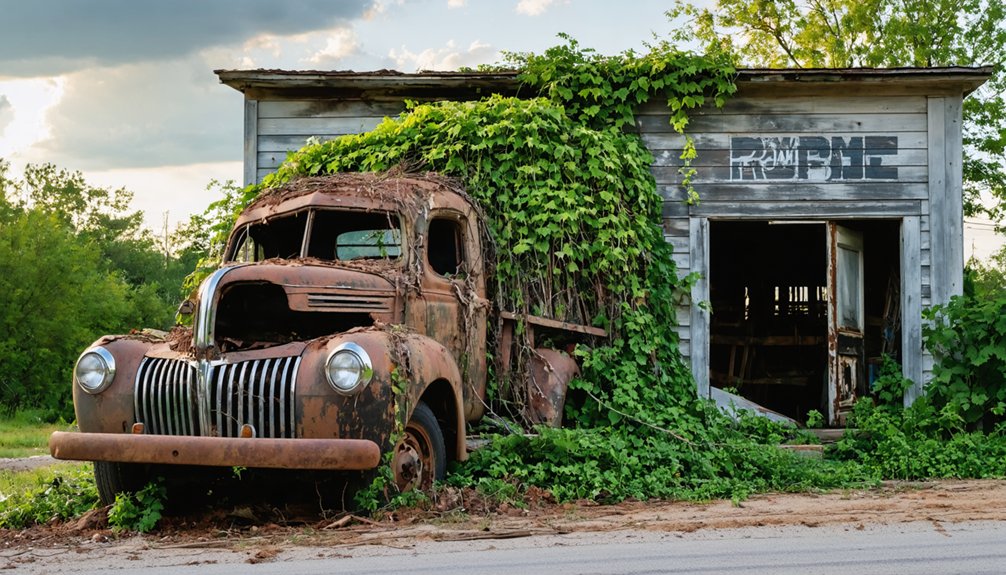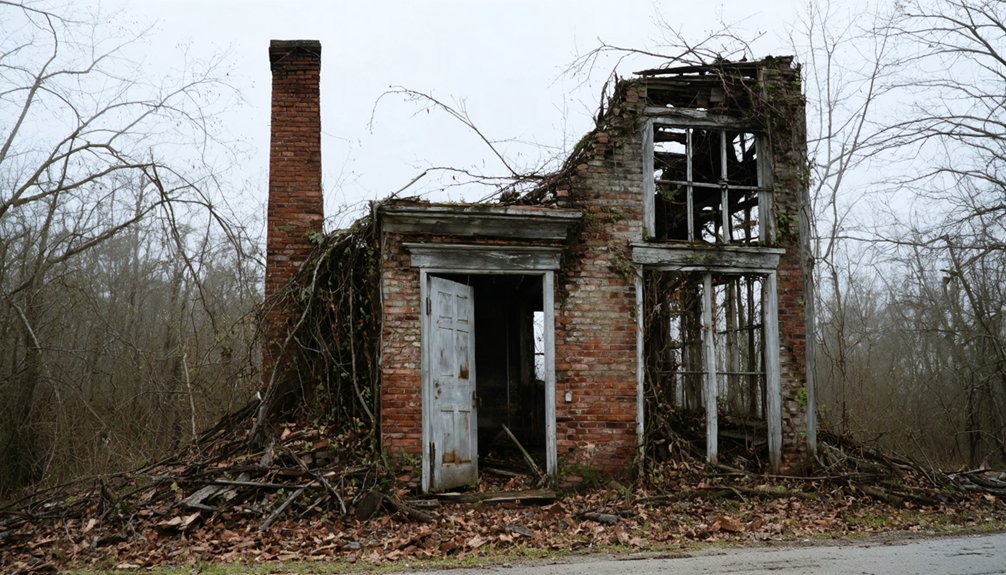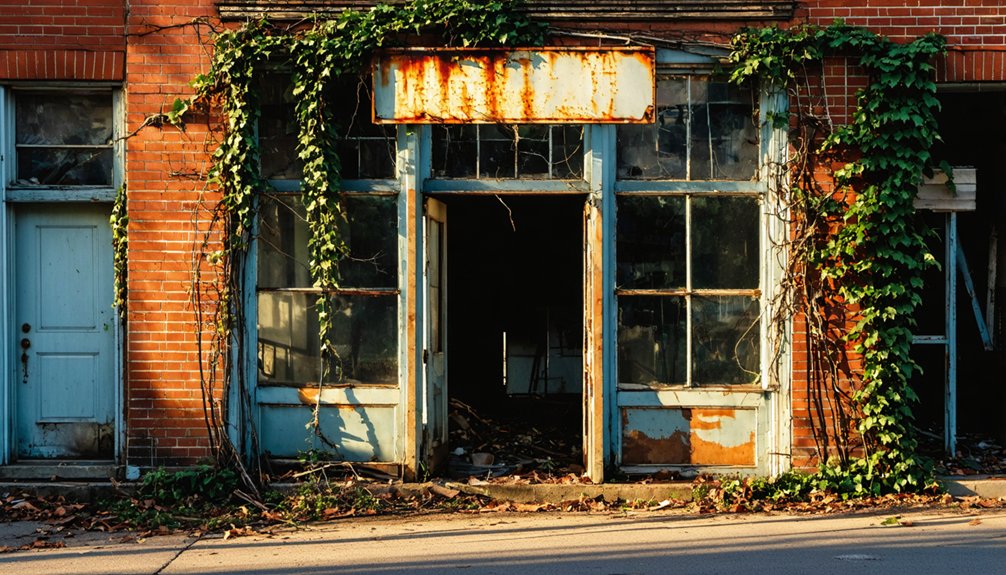You’ll find Aigleville’s remains near the confluence of Alabama’s Tombigbee and Black Warrior Rivers, where French Bonapartists and Saint-Domingue refugees established a settlement in 1818. Named after Napoleon’s eagle standard, this Vine and Olive Colony settlement struggled with frontier life and climate challenges. Though most settlers abandoned the site by the 1830s, scattered artifacts and place names like nearby Demopolis preserve fascinating traces of this French imperial experiment in early America.
Key Takeaways
- Aigleville was established in 1818 by French Bonapartist exiles near Alabama’s Tombigbee and Black Warrior Rivers but was abandoned by the 1830s.
- The settlement was part of the Vine and Olive Colony, where French settlers attempted but failed to establish vineyards in Alabama.
- By 1842, only one structure remained standing: the house of General Lefèbvre-Desnoëttes, while nature reclaimed the rest.
- Archaeological evidence includes scattered artifacts along riverbanks, such as broken glass, bricks, and metal fragments from the settlement period.
- The ghost town’s location is in present-day Marengo County, Alabama, at 161 feet elevation with evidence of former French cultural influence.
The French Imperial Connection
When Napoleon’s empire crumbled in 1815, a group of devoted Bonapartists and Saint-Domingue refugees sought to establish a new French settlement in Alabama, founding Aigleville in late 1818.
As French exiles fleeing the Bourbon Restoration, they settled near the confluence of the Tombigbee and Black Warrior Rivers in present-day Marengo County.
You’ll find their imperial aspirations reflected in the settlement’s very name – Aigleville honors Napoleon’s Grande Armée eagle standard.
The colonists received their land through a U.S. Congressional grant, but their dream extended beyond mere settlement. They aimed to preserve French imperial ideals on American soil, naming nearby locations after Napoleonic battles like Marengo and Linden.
Regular visits from French dignitaries, including Lafayette himself, helped maintain strong cultural ties with their homeland. The settlement’s population followed patterns similar to its French namesake, reaching 104 residents by 1990.
Their ambitious plan to cultivate grapes and olives faced numerous challenges, with crop failures and disease devastating the settlement between 1818 and 1822.
Life in Early Aigleville Settlement
Life in Aigleville bore little resemblance to the grand French imperial dreams that sparked its founding. The settlement challenges were evident from the start when it was established in late 1818 as part of the Vine and Olive Colony.
You’ll find that settlers received three types of land: a town lot, garden lot, and farm lot, but they struggled to make these properties prosperous. The colony faced numerous hardships that led to its complete abandonment by 1830s.
The community dynamics reveal a striking pattern – most inhabitants preferred nearby Demopolis and Greensboro, leaving Aigleville sparsely populated.
Despite the presence of Napoleon’s former high-ranking officials, including Count Charles Lefebvre-Desnouettes, the settlement remained quiet and uneventful.
The Vine and Olive Colony Dream
The ambitious Vine and Olive Colony emerged in 1817 as a sanctuary for French Bonapartist exiles seeking refuge from persecution after Napoleon’s fall. Congress granted them four townships near present-day Demopolis, Alabama, at $2 per acre, with the condition they’d engage in vine cultivation and olive production to demonstrate peaceful intentions.
You’ll find this agricultural dream was ill-fated from the start. The French settlers, unfamiliar with frontier life, struggled against Alabama’s unforgiving climate and soil conditions. These military aristocrats’ background made them poorly suited for farming life. Despite their determination, the colonists couldn’t sustain their planned vineyards and olive groves. They established the communities of Aigleville and Arcola as part of their settlement efforts.
Instead, many adapted to the local plantation system or returned to France. While the agricultural venture failed, the colony’s legacy lives on in Marengo County’s cultural identity, named after Napoleon’s famous battle, and in the enduring stories of these pioneering settlers.
Notable Figures and Leadership
You’ll find General Lefèbvre-Desnoëttes at the forefront of Aigleville’s leadership, directing the settlement’s construction and administration as part of the broader Vine and Olive Colony initiative in 1818.
While other Bonapartist officers and Saint-Domingue refugees joined the settlement’s founding, they operated under an informal leadership structure that allocated three land parcels to each settler. As a testament to his influence, his house survived until at least 1842 when a government resurvey was conducted.
The French military influence shaped the colony’s organization, as evidenced by both the imperial symbolism in the town’s name and the disciplined approach to community planning, though these efforts ultimately couldn’t prevent the settlement’s decline by the 1830s. Similar to Old Cahawba Archaeological Park, the site now serves as a reminder of Alabama’s rich settlement history.
French Military Leaders
Among the most influential figures in Aigleville’s establishment, General Charles Lefebvre-Desnouettes commanded the French Bonapartist refugees who founded the Vine and Olive Colony in Alabama’s wilderness.
As president of the Colonial Society, he directed the construction of Aigleville, named for Napoleon’s Imperial Eagle, and implemented a military hierarchy in land distribution.
You’ll find that French leadership extended beyond Lefebvre-Desnouettes to include General Charles Lallemand, who led a separate group of exiles in Texas.
While Lallemand’s efforts ultimately failed due to Spanish pressure, the military structure in Aigleville initially provided organization for the settlement.
In his log cabin home, Lefebvre-Desnouettes maintained a Shrine of Napoleon where fellow exiles could worship their fallen emperor.
The unsuitable Alabama climate conditions made growing grapes and olives nearly impossible for the settlers.
However, by 1830, most Napoleonic veterans had abandoned the colony, marking the end of French military influence in this ambitious venture.
Refugee Colony Organizers
Leadership within the Vine and Olive Colony extended far beyond military command, encompassing a diverse network of organizers who shaped the settlement’s development.
Their refugee resilience was evident through the coordinated efforts of the French Emigrant Association, led by Count Charles Lallemand, which masterfully orchestrated the colony’s establishment.
You’ll find these key elements of colony cooperation:
- Philadelphia-based organizers chartered vessels like the schooner McDonough and coordinated settler arrivals.
- Settlement coordinators managed land allocation and community planning, working closely with U.S. Treasury agents.
- Local liaisons facilitated essential relationships with Native Americans and U.S. authorities.
The colony’s social fabric was further strengthened by influential figures like Simon Chaudron and Benoît Chassériau, who contributed their expertise to administrative and cultural development.
General Lefebvre-Desnouettes demonstrated agricultural leadership by instructing refugees in plowing and other farming techniques.
Settlement Authority Structure
While establishing the French refugee settlement of Aigleville in 1818, General Lefèbvre-Desnoëttes emerged as the central authority figure who directed the town’s development and symbolized its Bonapartist heritage.
Under his leadership, settlement governance reflected French military traditions and colonial administrative practices.
The authority dynamics centered around a hierarchy of French military officers and former nobility from Saint-Domingue, who brought their colonial governance experience to manage land distribution and internal affairs.
You’ll find that leadership councils coordinated daily operations, though formal records remain sparse.
These Bonapartist leaders aimed to create an autonomous colony, using symbols like the French Imperial Eagle to unify settlers.
Even as the population declined by the late 1830s, Lefèbvre-Desnoëttes’s residence stood as a reflection of the settlement’s organized beginnings.
Geography and Natural Setting
Located in Marengo County, Alabama, Aigleville sat at an elevation of 161 feet above sea level near the confluence of the Black Warrior and Tombigbee Rivers.
The town’s geological features included sedimentary rock formations, fertile alluvial soils, and gently rolling terrain typical of Alabama’s Gulf Coastal Plain.
The landscape revealed layers of ancient rock, rich riverside soil deposits, and gentle hills characteristic of coastal Alabama’s geologic heritage.
You’ll find this ghost town’s natural setting characterized by:
- Mixed hardwood forests of oaks, hickories, and pines, contrary to early engravings showing non-native palms
- A humid subtropical climate with hot summers, mild winters, and 56 inches of annual rainfall
- River access that proved essential for transportation and trade, though the settlement relocated inland after a land grant survey error
The area’s rich soils and abundant wildlife supported early settlers, despite their unsuccessful attempts at grape and olive cultivation.
The Decline and Abandonment
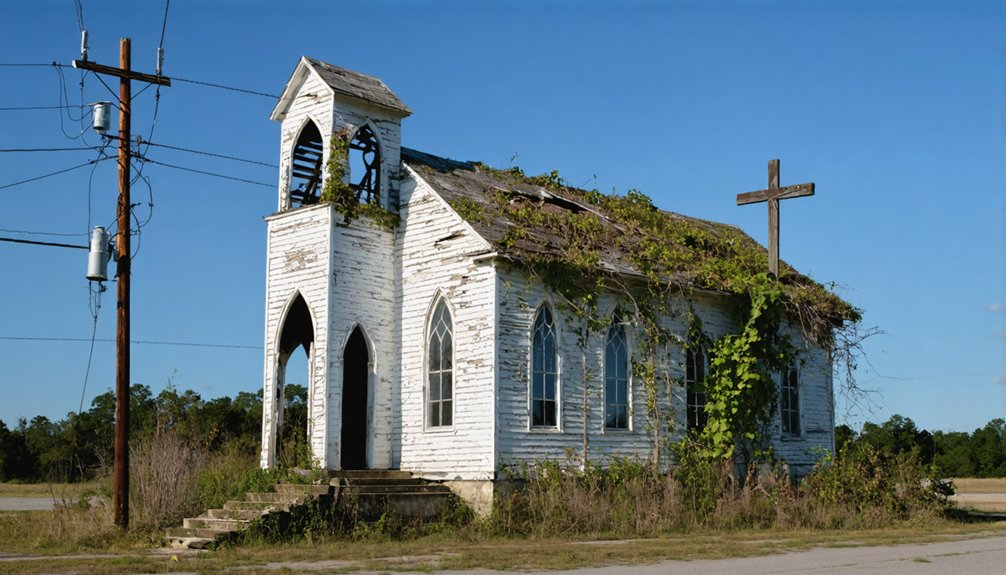
The promising natural setting of Aigleville couldn’t prevent its eventual downfall. The settlement’s decline began in the late 1830s when you’d have witnessed most residents abandoning their properties due to severe economic challenges.
The French expatriates’ settlement strategies proved ineffective, as they lacked experience with the region’s agricultural demands and failed to establish viable grape and olive cultivation.
You would’ve seen the town’s infrastructure deteriorate as inhabitants moved to more prosperous nearby communities like Demopolis and Greensboro. By 1842, only General Lefèbvre-Desnoëttes’ house remained standing.
Without a stable economic foundation or sustained population growth, Aigleville’s fate was sealed. The site gradually surrendered to forest reclamation until the 20th century, when industrial development transformed the landscape, erasing most traces of the original settlement.
Archaeological Discoveries and Remnants
Modern archeological evidence from Aigleville remains sparse, though scattered artifacts continue surfacing along its former riverbank locations.
Relic hunting along the waterways has revealed domestic items and construction materials, offering glimpses into the settlement’s physical remnants.
You’ll find these key archeological findings throughout the area:
- Broken glass, bricks, and metal fragments near the riverbanks, indicating former building sites and refuse dumps
- Late 19th and early 20th-century bottles and pottery shards, suggesting continued activity after the town’s initial abandonment
- Lumber and tongue-and-groove wood pieces, potentially linked to historical construction or mill operations
While General Lefèbvre-Desnoëttes’ house stood until 1842, the site’s transformation through industrial development and forest growth has largely obscured the original town’s footprint.
Legacy in Alabama History
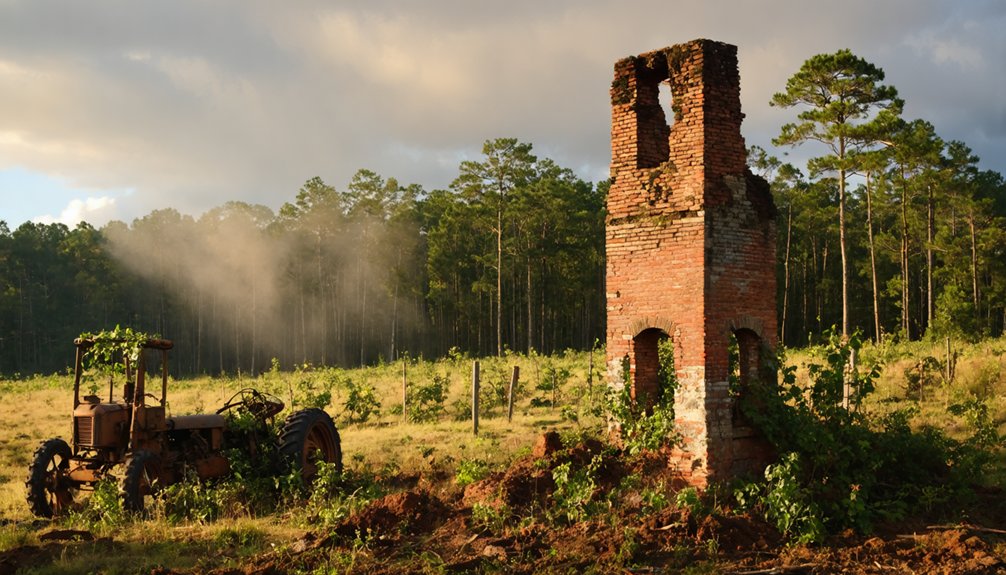
You’ll find Aigleville’s lasting French cultural influence reflected in Alabama’s historical narrative through its unique connection to Napoleonic heritage and the Vine and Olive Colony experiment.
The French Imperial Eagle symbolism and the settlers’ ambitious agricultural vision showcase a distinctive period of French-American cultural exchange in Alabama’s early development.
Despite the colony’s eventual failure, Aigleville’s legacy lives on as a proof of the diverse cultural influences that shaped Alabama’s identity during the early 19th century.
French Culture’s Lasting Impact
While Aigleville’s physical structures have largely vanished, French cultural influences from the Vine and Olive Colony continue to shape Alabama’s historical landscape.
You’ll find their lasting impact through:
- Agricultural practices they introduced, including European viticulture techniques and olive cultivation methods, even though these crops ultimately failed in Alabama’s climate.
- Settlement patterns reflecting French land-use principles, with settlers receiving multiple lots for town living, gardening, and farming.
- Architectural heritage preserved in structures like the Noel-Ramsey Home in Greensboro.
These French cultural influences extend beyond Aigleville’s borders through preserved artwork, including an 1820 panoramic painting that captures colony life through wallpaper reproductions now housed in Alabama archives.
You’ll also notice their legacy in place names like Demopolis, meaning “City of the People,” which reflects their democratic ideals.
Napoleonic Heritage Lives On
The Napoleonic spirit that drove Aigleville’s founding remains etched in Alabama’s historical fabric through distinct symbols and traditions.
You’ll find this legacy in the town’s very name, which honored Napoleon’s Imperial Eagle, and in the structured agricultural practices that reflected Bonapartist organizational methods.
While the physical settlement didn’t survive, its Napoleonic identity lives on in Demopolis and throughout Marengo County.
The ambitious vision of General Lefèbvre-Desnoëttes and his fellow refugees shaped local farming approaches and left an indelible mark on the region’s cultural landscape.
Even as the original vine and olive colony failed, the settlement’s story became woven into Alabama’s narrative, preserving the memory of these French expatriates who sought to establish their own piece of Napoleonic France in the American frontier.
Frequently Asked Questions
What Modern-Day Structures or Buildings Exist on the Former Aigleville Site?
You’ll find cement production facilities and industrial buildings on the site today, with no visible historical remnants. The modern structures are primarily related to active manufacturing operations.
Were Any Artifacts From Aigleville’s French Settlers Recovered During Industrial Development?
You won’t find records of any artifact recovery from the French settlers during industrial development. While industrial archaeology opportunities likely existed, there’s no documented evidence of findings from the site.
Did Any Descendants of Original Aigleville Settlers Remain in Marengo County?
You’ll find limited documented descendant stories about Aigleville’s settlers in Marengo County. While some family connections may have endured, historical records don’t conclusively confirm who stayed in the area.
What Happened to the Original Land Deeds of Aigleville Settlers?
Ever wonder about lost pieces of history? You won’t find the original land deeds – historical records indicate they were likely lost during the colony’s collapse, with no surviving ownership documents in county or state archives.
Are There Any Annual Events or Commemorations Celebrating Aigleville’s French Heritage?
You won’t find any annual festivals specifically commemorating Aigleville’s French heritage today. While Alabama celebrates French colonial history through events in Mobile and Fort Toulouse, none directly honor Aigleville’s unique past.
References
- https://digitalalabama.com/alabama-ghosts-and-ghost-towns/aigleville-alabama/2794/
- https://kids.kiddle.co/Aigleville
- https://www.tripadvisor.com/ShowUserReviews-g30754-d3405413-r702542512-Old_Cahawba_Archaeological_Park-Orrville_Alabama.html
- https://digitalalabama.com/alabama-ghost-towns/aigleville-alabama/2794
- https://en.wikipedia.org/wiki/List_of_ghost_towns_in_Alabama
- https://encyclopediaofalabama.org/article/vine-and-olive-colony/
- https://en.wikipedia.org/wiki/Aigleville
- https://france-amerique.com/300-years-of-french-culture-in-alabama/
- http://lesleyannemcleod.blogspot.com/2011/08/regency-in-alabama-vine-olive-colony-of.html
- https://penelope.uchicago.edu/Thayer/E/Gazetteer/Places/America/United_States/Alabama/_Texts/French_Military_Adventurers_in_Alabama*.html
